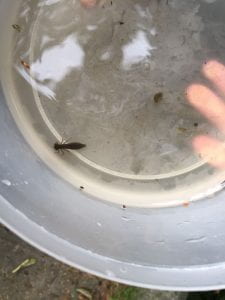Aquatic Field Studies
In Science 9 Honours, our class learned about the 4 Spheres, Water Quality and Invertebrates. After we have learned about these, we went to the Coquitlam River and the Oxbow Pond behind our school and did experiments. Because it is water, we discovered the hydrosphere and took the temperature of the water. We also looked at the biosphere because we also investigated the aquatic marine life in the water and identifying if the water quality is good, fair, or poor by looking at what type of invertebrates live in the water.
We started our experiment by going to the Coquitlam River first. We didn’t do much, but we took the temperature of the water. And we got a result of 2 degrees of temperature change. Our group consisted of 4 people and we took turns of who go into Chest Waders and lifejackets and going in the water.
George in his chest waders and lifejacket, all set
A couple of days later, we went back and this time, we went into the deep parts of the river and got a net and scrubbed rocks in front of the net so that the debris can get caught in the net.
Lucas scrubbing rocks and collecting particles that fall from the rock
After, we emptied the net into a bucket and tried to find invertebrates. Later, we found a very microscopic invertebrate that we could not identify. We found a small log later and decided to flip it because we thought that a lot of insects would be under it. We flipped it and found three invertebrates. We found two Stonefly larvae and a small worm like critter that we think that is a leech.
Stonefly Larva Leech Microscopic (?)
After we recorded the data, we checked a package of papers with two Appendixs. Appendix 1 shows the types of invertebrates that we could find in good, fair or poor water qualities. Appendix 2 can help you figure out what kind of invertebrate that you could have found could be. We checked Appendix 1 and found out that most of the invertebrates that we found were “Pollution sensitive organisms found in good quality water”. So it meant that the water quality was good. We got bucket of the river water and tested it on pH paper. pH is the level of the water quality. 1-5 would mean that the water is acidic, 9-14 would mean that it is basic and about 6-8 would mean that it is good water quality. So, we tested the water several times and found out that the average pH level was about 6.5-7 which means the water of the river is very good.
After we have finished at the river, as a class, we started our new experiment at the Oxbow Pond behind the school. You could clearly see that the water quality will be not like the river because the colour of the water was extremely mucky and it was not clear and my general reaction was excitement because the water quality is different, there is a higher chance that we will find different invertebrates. As expected, we have found different types of invertebrates. In the pond, we found a couple of aquatic sow bugs, a single dragonfly suborder, quite some dragonfly nymphs and a water mite. And the interesting part about this is that if you look at Appendix 1, and if you find all these invertebrates, you will see that below all the invertebrates in that section, it will say that these invertebrates are pollution tolerant but are able to live in clean water also. That basically says it all. The colour of the water and the types of invertebrates that we found matches perfectly. This time, we did not scrape rocks and hope it flowed into our nets because one, there is no stream and two, if we scrub rocks, all we are going to get is mud. So what we did is we got our nets and swiped it around the water and collected particles of the pond. Later, we collected the cleanest pond water we could find, flipped the net over above our bucket and poured the water over the net so all the particles that have been caught in the net can flow into the bucket. It was quite hard to identify which of the things in the bucket were actual invertebrates or if they were merely a woodchip.
Dragonfly Nymph Snail, Nymph and Fish Dragonfly Suborder
As we did at the river, we collected water samples of the pond. We tested the water on pH paper and found out that the pH level was okay. The water was livable but not drinkable.
I bet that these experiments were one of the best science experiments that I’ve done. The fact of going in water with Chest Waders and collecting bugs was extremely cool for me. 100%, this experiment has helped me for this unit because I think I learn better when I do something rather than listening to the teacher speak the whole block. I helps more because I get more of a visual explanation of the unit because if we said that we were catching invertebrates, I wouldn’t know what they were and how it felt like to catch a real one. It also might help for others because they have fun doing the experiment and I heard that people understand and learn better when they have fun or interest in the experiment and I also think that even the people that don’t like a specific experiment will end up liking it because they probably had fun. In conclusion, this helped me understand more about invertebrates and water quality and I one hundred percent recommend this for the future grade 9’s and one thing. DO NOT MISS OUT ON THIS OR YOU WILL REGRET IT.![]()







